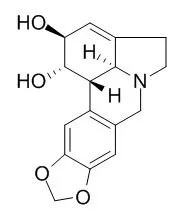| Description: |
Lycorine is a toxic crystalline alkaloid found in various Amaryllidaceae species that weakly inhibits acetylcholinesterase (AChE) and ascorbic acid biosynthesis.Lycorine has antiviral, and anti-cancer effects, the mechanisms of Lycorine on the multiple myeloma cell line ARH-77 are associated with G1 phase cell cycle arrest, mitochondrial dysfunction, reactive oxygen species (ROS) generation, ATP depletion, and DNA damage.
|
| In vitro: |
| Tumour Biol. 2015 Apr;36(4):2937-45. | | Lycorine induces programmed necrosis in the multiple myeloma cell line ARH-77.[Pubmed: 25487618] | Lycorine, a natural alkaloid, has been widely reported to possess potential efficacy against cancer. However, the anti-multiple myeloma mechanism of Lycorine is not fully understood.
METHODS AND RESULTS:
In this study, the results demonstrated that Lycorine is effective against multiple myeloma cell line ARH-77 via inducing programmed necrosis. The mechanisms of Lycorine on the multiple myeloma cell line ARH-77 are associated with G1 phase cell cycle arrest, mitochondrial dysfunction, reactive oxygen species (ROS) generation, ATP depletion, and DNA damage.
CONCLUSIONS:
Our results elucidate the new mechanism of Lycorine against multiple myeloma. |
|
| In vivo: |
| Oncotarget. 2015 Apr 12. | | Lycorine is a novel inhibitor of the growth and metastasis of hormone-refractory prostate cancer.[Pubmed: 25915156] | Lycorine, a natural alkaloid extracted from the Amaryllidaceae plant family, has been reported to exhibit a wide range of physiological effects, including the potential effect against cancer. However, the anti-prostate cancer (PCa) efficacy of Lycorine remains unrevealed. In this context, we figured out Lycorine's anti-proliferative and anti-migratory properties for PCa treatment.
Lycorine inhibited proliferation of various PCa cell lines, induced cell apoptosis and cell death.
METHODS AND RESULTS:
Here we showed that Lycorine decreased proliferation, migration, invasion, survival and EMT of prostate cancer cell lines. Subcutaneous and orthotopic xenotransplantations by ectopic implantation of the human hormone-refractory PC-3M-luc cells were used to confirm in vivo anticancer effects of Lycorine. Lycorine inhibited both growth and metastasis in multiple organs (liver, lung, kidney, spleen and bone) in vivo and improved mice survival. Lycorine prevented EGF-induced JAK/STAT signaling. Importantly, anti-cancer effects of Lycorine were dependent on STAT expression.
CONCLUSIONS:
We suggest that Lycorine is a potential therapeutic in prostate cancer. | | Autophagy . 2021 Jul;17(7):1592-1613. | | Discovery of a potent SCAP degrader that ameliorates HFD-induced obesity, hyperlipidemia and insulin resistance via an autophagy-independent lysosomal pathway[Pubmed: 32432943] | | Abstract
SCAP (SREBF chaperone) regulates SREBFs (sterol regulatory element binding transcription factors) processing and stability, and, thus, becomes an emerging drug target to treat dyslipidemia and fatty liver disease. However, the current known SCAP inhibitors, such as oxysterols, induce endoplasmic reticulum (ER) stress and NR1H3/LXRα (nuclear receptor subfamily 1 group H member 3)-SREBF1/SREBP-1 c-mediated hepatic steatosis, which severely limited the clinical application of this inhibitor. In this study, we identified a small molecule, Lycorine, which binds to SCAP, which suppressed the SREBF pathway without inducing ER stress or activating NR1H3. Mechanistically, Lycorine promotes SCAP lysosomal degradation in a macroautophagy/autophagy-independent pathway, a mechanism completely distinct from current SCAP inhibitors. Furthermore, we determined that SQSTM1 captured SCAP after its exit from the ER. The interaction of SCAP and SQSTM1 requires the WD40 domain of SCAP and the TB domain of SQSTM1. Interestingly, Lycorine triggers the lysosome translocation of SCAP independent of autophagy. We termed this novel protein degradation pathway as the SQSTM1-mediated autophagy-independent lysosomal degradation (SMAILD) pathway. In vivo, Lycorine ameliorates high-fat diet-induced hyperlipidemia, hepatic steatosis, and insulin resistance in mice. Our study demonstrated that the inhibition of SCAP through the SMAILD pathway could be employed as a useful therapeutic strategy for treating metabolic diseases.Abbreviation: 25-OHD: 25-hydroxyvitamin D; 3-MA: 3-methyladenine; ABCG5: ATP binding cassette subfamily G member 5; ABCG8: ATP binding cassette subfamily G member 8; ACACA: acetyl-CoA carboxylase alpha; AEBSF: 4-(2-aminoethyl) benzenesulfonyl fluoride hydrochloride; AHI: anhydroicaritin; AKT/protein kinase B: AKT serine/threonine kinase; APOE: apolipoprotein E; ATF6: activating transcription factor 6; ATG: autophagy-related; BAT: brown adipose tissue; CD274/PD-L1: CD274 molecule; CETSA: cellular thermal shift assay; CMA: chaperone-mediated autophagy; COPII: cytoplasmic coat protein complex-II; CQ: chloroquine; DDIT3/CHOP: DNA damage inducible transcript 3; DNL: de novo lipogenesis; EE: energy expenditure; EGFR: epithelial growth factor receptor; eMI: endosomal microautophagy; ERN1/IRE1α: endoplasmic reticulum to nucleus signaling 1; FADS2: fatty acid desaturase 2; FASN: fatty acid synthase; GOT1/AST: glutamic-oxaloacetic transaminase 1; GPT/ALT: glutamic-pyruvate transaminase; HMGCR: 3-hydroxy-3-methylglutaryl-CoA reductase; HMGCS1: 3-hydroxy-3-methylglutaryl-CoA synthase 1; HSP90B1/GRP94: heat shock protein 90 beta family member 1; HSPA5/GRP78: heat hock protein family A (Hsp70) member 5; HSPA8/HSC70: heat shock protein family A (Hsp70) member 8; INSIG1: insulin induced gene 1; LAMP2A: lysosomal associated membrane protein 2A; LDLR: low density lipoprotein receptor; LyTACs: lysosome targeting chimeras; MAP1LC3B/LC3B: microtubule associated protein 1 light chain 3 beta; MBTPS1: membrane bound transcription factor peptidase, site 1; MEF: mouse embryonic fibroblast; MST: microscale thermophoresis; MTOR: mechanistic target of rapamycin kinase; MVK: mevalonate kinase; PROTAC: proteolysis targeting chimera; RQ: respiratory quotient; SCAP: SREBF chaperone; SCD1: stearoyl-coenzemy A desaturase 1; SMAILD: sequestosome 1 mediated autophagy-independent lysosomal degradation; SQSTM1: sequestosome 1; SREBF: sterol regulatory element binding transcription factor; TNFRSF10B/DR5: TNF receptor superfamily member 10b; TRAF6: TNF receptor associated factor 6; UPR: unfolded protein response; WAT: white adipose tissue; XBP1: X-box binding protein 1. |
|






 Cell. 2018 Jan 11;172(1-2):249-261.e12. doi: 10.1016/j.cell.2017.12.019.IF=36.216(2019)
Cell. 2018 Jan 11;172(1-2):249-261.e12. doi: 10.1016/j.cell.2017.12.019.IF=36.216(2019) Cell Metab. 2020 Mar 3;31(3):534-548.e5. doi: 10.1016/j.cmet.2020.01.002.IF=22.415(2019)
Cell Metab. 2020 Mar 3;31(3):534-548.e5. doi: 10.1016/j.cmet.2020.01.002.IF=22.415(2019) Mol Cell. 2017 Nov 16;68(4):673-685.e6. doi: 10.1016/j.molcel.2017.10.022.IF=14.548(2019)
Mol Cell. 2017 Nov 16;68(4):673-685.e6. doi: 10.1016/j.molcel.2017.10.022.IF=14.548(2019)